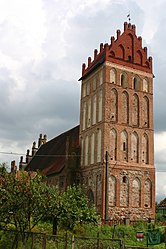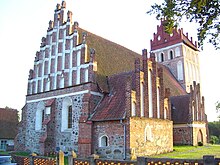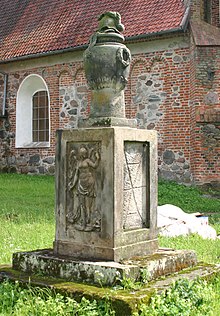St. Anna (Mołtajny)
| Church of St. Anna in Mołtajny (Kościół Ŝwiętej Anny w Mołtajnach) Church of Molthainen (Molteinen) |
|
|---|---|
|
The former Protestant, now Catholic parish church in Mołtajny (Molthainen / Molteinen) |
|
| Construction year: | around 1384 |
| Style elements : | Field stone and brick construction , brick Gothic |
| Location: | 54 ° 17 '48.2 " N , 21 ° 21' 0.8" E |
| Address: | No. 28 Mołtajny Warmia-Masuria , Poland |
| Purpose: | Roman-Catholic , until 1945 Evangelical-Lutheran parish church |
| Parish: | 11-410 Mołtajny |
| Diocese : | Archdiocese of Warmia , Deanery Kętrzyn II |
The Church of St. Anna in Mołtajny ( German Molthainen , 1938 to 1945 Molteinen ) is a building from the end of the 14th century. Until 1945 it was the central church of the Protestant parish Molthainen (Molteinen) in East Prussia and is now a Roman Catholic parish church in the Polish Warmian-Masurian Voivodeship .
Geographical location
Mołtajny is located in the northern center of the Warmian-Masurian Voivodeship, not far from the border with the Russian Kaliningrad Oblast (Königsberg region) . The village can be reached from Aptynty ( German Aftinten ) on Voiwodschaftsstraße 591 (former German Reichsstraße 141 ).
The church is located in the southwest of the village not far from the Arklitter Lake ( Jezioro Arklickie in Polish ).
Church building
The church in Molthainen is a church from around 1384. The rectangular, plastered building was made of field stones and bricks in the brick Gothic style , with a stepped gable in the east and a western tower . The latter is richly decorated with bezels and pinnacles , around the 16th century it was increased. The sacristy from around 1500 has star vaults inside and is comparatively large. The vestibule probably dates from before 1400 and is vaulted inside by a wooden barrel ceiling.
The church interior with galleries is vaulted by a wooden corner. The furnishings include the pulpit from 1782, which is installed above the altar that was created at the same time - also made in simple forms . It is said to be a foundation of the landowner and pastron Albrecht von und zum Egloffstein and his family from Arklitten ( Arklity in Polish ). The stalls date from the 16th century and were repainted in 1750. The large brass chandelier dates from the end of the 17th century .
In 1782, the organ builder Christoph Heinrich Obuch in Mohrungen ( Morąg in Polish ) built the organ of the church, which is located on the west gallery. The movement is single manual with pedal and has 14 registers.
The ringing originally consisted of three bells , one of which bore the inscription "Cast in 1500".
After 1945 the church became the property of the Roman Catholic Church . It is again a parish church , now dedicated to St. Anna . A painting of her is said to have been kept in the church tower until 1730. The interior design of the church was changed according to the new liturgical usage.
Parish
A church in Molthainen was first mentioned in 1384. Its foundation is therefore pre-Reformation. In 1486 a pastor Balthasar Lößenstein officiated here . Molthainen belonged to the supervisory district of the archpriest of Schippenbeil ( Polish Sępopol ) until the Reformation .
Evangelical
Church history
With the arrival of the Reformation in East Prussia , the Molthain Church became a Protestant church. Until 1945 it belonged to the Gerdauen parish in the church province of East Prussia of the Church of the Old Prussian Union . The parish was a patronage parish . The patron saint of the church was the landowner von Arklitten (in Polish Arklity ), in the 1920s the Count von und zum Egloffstein , who resided in Kromlau near Weißwasser / Oberlausitz . In 1925, the Molthain parish had a total of 1,950 parishioners who lived in almost 20 villages, towns and places.
The evacuation and expulsion of the local population put an end to the work of the Protestant parish in Molthainen. The few Protestant church members living here today belong to the parish in Barciany (Barten) , a branch parish of the parish Kętrzyn (Rastenburg) in the Masurian diocese of the Evangelical-Augsburg Church in Poland .
Parish places
Until 1945, the parish of Molthainen (Molteinen) included the following villages, localities and residential areas:
| German name | Polish name | German name | Polish name | |
|---|---|---|---|---|
| * Aft inks | Aptynty | Fritzendorf | Frączkowo | |
| Old hail | Gradowo | Koskeim | Koskajmy | |
| * Arklitten | Arklity | Frills | Kotki | |
| mountain | Górki | Markhausen | Markuzy | |
| Berthawerth | Mint meadow | Mintowo | ||
| * Bieberstein | Bobrowo | Rauttershof | Ruta | |
| Blandau | Błędowo | Darling | Czaczek | |
| * Doyen 1938–1945 Dugen |
Duje | Schatzelshöfchen | Cacki | |
| Egloffstein | Główczyno | Welcome comb | Wielewo |
Pastor
From the Reformation until 1945 the pastors officiated at the Molthainen church as evangelical clergy:
- N. Kruger, 1560
- Balthasar Eyben, from 1587
- Michael Wegner, 1601
- Severin Ursinus, 1630
- Peter Marquard, 1644-1679
- Christian Gottlieb Marquard, 1680-1711
- Christoph Theodor Marquard, 1711–1728
- Johann Friedrich Kahnert, 1728–1742
- Daniel Christoph Kalau, 1743–1776
- Georg Karl Schleswig, 1776-1810
- Johann Gotthard Graap, 1811–1833
- Julius Christlieb Heinersdorff, 1833–1875
- Bernhard Julius Hoppe, 1875–1884
- Eduard Rudolf Wilh. Rousselle, 1884-1898
- Hermann Friedrich Wilhelm Boye, 1898–1901
- Hermann Erich Kramm, 1901–1920
- Kurt Steinwender, 1910–1915
- Adalbert Schwede, 1915-1918
- Horst Schirmacher, 1919–1921
- Friedrich Schauer , 1920–1929
- Bernhard Kreutzberger, 1930–1931
- Gottmar Helmut Kuessner, 1931–1935
- Friedrich Naujoks, 1936–1937
- Günther Hartwig, until 1939
Church records
The parish register records of the Molthainen (Molteinen) parish have been preserved and are kept at the German Central Office for Genealogy in Leipzig :
- Baptisms: 1660-1723, 1764-1874
- Weddings: 1645–1729, 1734–1767, 1800–1874
- Burials: 1645–1821, 1828–1874
Catholic
Before 1945 there were relatively few Catholics in the Molthainen region. They were parish in the church of St. Bruno in Insterburg (today in Russian: Chernyachovsk ) in what was then the diocese of Warmia .
Due to the resettlement of numerous Polish citizens in the village then called "Mołtajny", the number of Catholic residents increased. They took over the previously evangelical church as their church. Mołtajny became a parish, to which the branch church in Aptynty ( German Aftinten ) was added later . The parish belongs to the deanery Kętrzyn II (Rastenburg northeast) in the current Archdiocese of Warmia .
Web links
Individual evidence
- ↑ a b c Mołtajni - Molthainen / Molteinen at ostpreussen.net
- ↑ a b c Walther Hubatsch : History of the Protestant Church in East Prussia. Volume 2 Pictures of East Prussian Churches. Göttingen 1968, p. 40, fig. 71
- ^ A b Parish Mołtajny in the Archdiocese of Warmia
- ↑ a b c d Walther Hubatsch: History of the Protestant Church in East Prussia. Volume 3 documents. Göttingen 1968, p. 458
- ↑ parish Molthainen
- ↑ The * indicates a school location
- ↑ Friedwald Moeller: Old Prussian Evangelical Pastors' Book from the Reformation to the Expulsion in 1945. Hamburg 1968, p. 97




